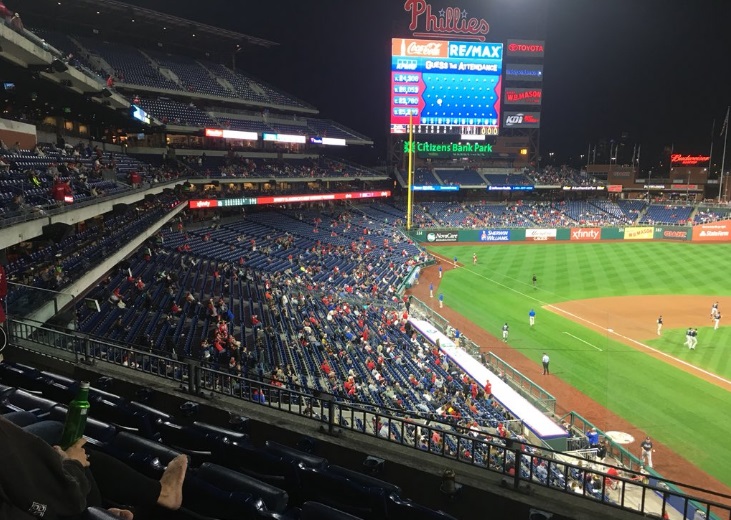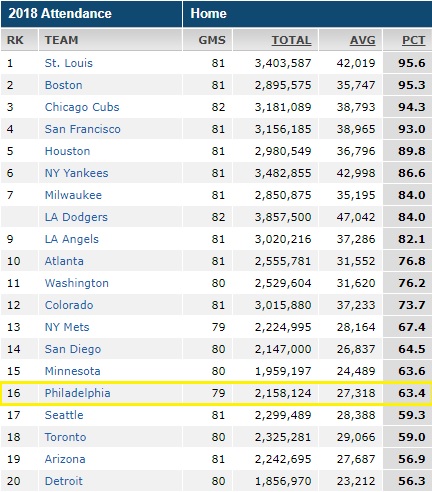Ad Disclosure
Baseball Attendance was Down this Season

From Eric Fisher at the Sports Business Journal:
Final 2018 MLB attendance with today's tiebreaker games: 69.67 million, down 4.1 pct from a year ago. Fifth drop in last six years, lowest total since 2003 and first season since '03 to fall below 70 million.
— Eric Fisher (@AEricFisher) October 2, 2018
Not good, but not surprising.
Could be a combination of factors, but I think the glut of analytics-backed pitching changes and slow pace of the game just doesn’t resonate with a Millennial generation that can’t stay off their smart phone for 15 seconds without becoming bored.
It also doesn’t help that you have about 8-10 teams that were utter dog shit this year, which bogs down the back end of the list. And larger market squads like Texas and Detroit having down years and pulling around 55% of ballpark capacity further drags down the overall number.
For what it’s worth, the Phils’ attendance increased this year, up by about 250,000, as Jim Salisbury writes over at NBC Sports Philadelphia:
A crowd of 34,202 was in the house on fan-appreciation day Sunday. That left the Phils with a final home attendance of 2,155,695. That does not include the “home” game that the Phils played against the Mets in Williamsport.
The Phils drew 1,905,354 last season. That had not reached 2 million in attendance since 2014.
Small victory there.
According to ESPN, the Phils averaged around 27,000 fans per game, which is up from 24,000 last year. Still, the 2018 number only accounts for about 63% of what Citizens Bank Park can hold.
This puts the Phils at 16th overall when you filter the numbers by percentage of stadium filled:
Some have posited that the increase in strikeouts and lack of base hits has simply brought down the value of a game from an entertainment standpoint. I’m sure there’s something to that, but it’s also just not worth going to a game anymore, is it?
Tickets are expensive. Concessions are expensive. Sometimes it’s more enjoyable to watch on your 55 inch high definition TV instead of schlepping down to the ballpark to drink overpriced beer while sweating your ass off behind left field.
Noah Frank I think summed this up nicely (from a Washington angle) in a July column for WTOP.com:
As is true with nearly any question, within the sports world and without, the answer is most often a financial one. Back when the Nats played at RFK, the most expensive regular seat was about $45, the cheapest about $7. According to Statista, the average ticket this season is more than $42, double what it was in 2007. Parking, which was far less expensive at the old digs, runs $50 at Lots B and C, just beyond the outfield wall at Nats Park. Hot dogs, beer, all of it is notably more expensive. For a family of four, the full cost of attendance has basically doubled since the final year at RFK.
Meanwhile, inflation-adjusted income has remained flat for all but the highest 20 percent of earners in the U.S. over that time. In other words, plenty of people who used to be able to take themselves or family to the ballpark simply can’t anymore.
….it also devalues the live experience when you can stay at home and watch the game for free instead of spending a minor fortune on exorbitantly priced parking, paying for tickets and hugely inflated concessions, and managing a whole family, some of which might not be nearly as interested in the baseball as you are.
All of that makes sense to me.
I also just feel like the product is diluted over the course of 162 games. I’m a soccer fan who finds the MLB regular season extremely boring but loves playoff baseball because the nuance of the game is more meaningful in smaller doses. Every pitching change is amplified and worthwhile strategically in a shorter playoff series. The stakes are obviously higher, the margins for error are slimmer, and therefore I don’t mind three and a half hours of baseball when it actually counts for something (and you’ve got two good teams playing the game).
I don’t know if Major League Baseball can do anything about the economy or the changing world of sports and entertainment consumption, but surely there’s a way to make the in-stadium experience great again.
Kevin has been writing about Philadelphia sports since 2009. He spent seven years in the CBS 3 sports department and started with the Union during the team's 2010 inaugural season. He went to the academic powerhouses of Boyertown High School and West Virginia University. email - k.kinkead@sportradar.com
